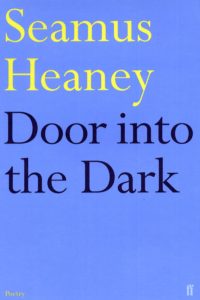I admit that my first time through Door into the Dark I did not get as much out of it as I did from Death of a Naturalist. Entering again, I see more in the rooms that Heaney is making, evoking, although there is much that is still murky to me. The titles of the first three poems tell readers what to expect: “Night-Piece,” “Gone,” and “Dream,” which is more of a nightmare, quick and made brutal by a sudden turn. He is headed to dark places, will call attention to absences, will explore the unconscious.
Heaney notes in Stepping Stones that “No poems were held over [from Death of a Naturalist] … From then on, it was start-again time.” (p. 89) Not only are they all new, but the years when he wrote the poems in this collection, 1965 to 1969, were particularly tumultuous. There’s little direct reflection of the political turmoil that shook the late 1960s, but art and literature becoming more experimental are at least echoed in Heaney’s poems that are more oblique than they were in Death of a Naturalist. Yes, a horse is gone in “Gone,” but what else? What plays “The Given Note”?
“The Forge” — which gives the volume its title from the poem’s first line “All I know is a door into the dark” — echoes the first collection’s opening poem. Where Heaney had been digging, finding, now he is working like a smith, forging, creating things poised between fantastic “Horned as a unicorn” and material “To beat real iron out, to work the bellows.” Heaney’s smith is a bit of a relic; he “recalls a clatter/Of hoofs where traffic is flashing in rows” in a time when trucks and autos are displacing horses. Not unlike poets who are of their times but also separate. “The Forge” is not quite a sonnet, tumbling out of the rhyme scheme in the last six lines, with final word in that section that poise “music,” “clatter,” and “a slam and flick” against each other. The smith, like the poet, “expends himself in shape and music.”
He writes of place, some more clearly identified than others. It seems likely that someone who knew Northern Ireland well could identify “The Peninsula,” and while “Night Drive” mentions road signs in France, its location is the road more generally, and the road on the way to one’s beloved. “At Ardboe Point,” by contrast, draws the general from the particular, the beloved found and drawn close.
Those lead toward “A Lough Neagh Sequence,” the volume’s strongest section. Dedicated “For the fishermen,” the set of seven poems takes readers into the lives of the lough’s fishermen, their legends and beliefs, their work and ways. The different lengths and structures of the poems capture different seasons on the water, different personalities among the fishermen, and different elements of the work — “Bait,” “Setting,” “Catch.” Two of the seven — “Beyond Sargasso” and “Return” — are written from the eels’ perspectives. In eight pages, Heaney catches a place, a way of life, and the physical world that ties them all together.
He closes again with a poem dedicated to another poet, this time “Bogland” for T.P. Flanagan. Heaney has opened a door into the dark, into the creative forge where sparks fly, where lives and landscapes afford countless possibilities. Though it is a small country — “We have prairies/To slice a big sun at evening — /Everywhere the eye concedes to/Encroaching horizon” — it is old and deep and fertile “Every layer they strip/Seems camped on before./The bogholes might be Atlantic seepage/The wet centre is bottomless.”


3 pings
[…] Out struck me as even more oblique than Door into the Dark, and I often struggled to see and hear what Heaney was connecting with. Not that they have to be […]
[…] of a Naturalist (1966) Door into the Dark (1969) Wintering Out (1972) North (1975) Field Work (1979) Station Island (1984) The Haw Lantern […]
[…] very oblique and intense book” because I found it not nearly as oblique as Wintering Out or Door Into the Dark. Heaney divided North into two parts, “a first section that has poems full of linguistic burr […]